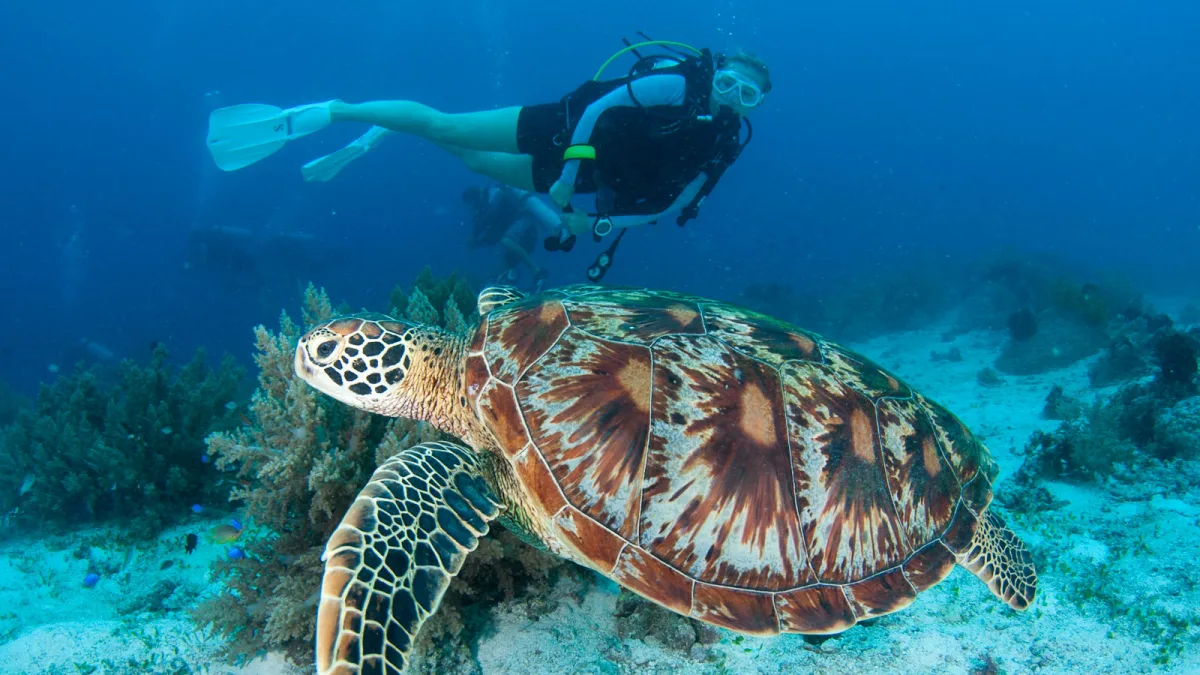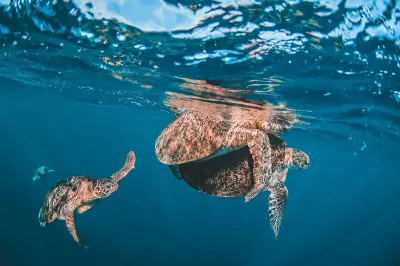Learn more about marine turtles - their habitat, behaviour and the threats they are now faced with across Asia.
The ancient relatives of modern sea turtles first evolved over 100 million years ago and today, these charismatic animals can be found across all of our planet’s warmer oceans and seas. Their close connection to the land has meant humans have always had a relationship with turtle species - mostly as a source of food - but in modern times they have become icons of the seas, and high on the wish list of snorkelers and divers alike. However, all seven sea turtle species are now listed as critically endangered or vulnerable and it is our responsibility as divers, travellers or lovers of the oceans to do what we can to ensure that the future of these remarkable animals is in safe hands.
Sea turtles today
Existing for more than 100 million years, sea turtles are one of Earth’s most ancient creatures. They are equally one of the most charismatic so much so that turtles have had starring roles on the big screen, such as in Finding Nemo. Yet it is their fragility, with all seven sea turtle species either critically endangered or vulnerable, that we must now look to protect to ensure the future of these iconic animals.
From the shallow seagrass beds of the Indian Ocean to the colourful reefs of the Coral Triangle, they embark on delicately balanced lifecycles; undergoing the ordeal of dragging themselves up beaches to lay clutches of eggs up to 150 strong whilst avoiding the threat of predation and human encroachment, upon hatching embarking on a treacherous journey into hungry seas, followed by decades of vulnerability to by-catch, habitat destruction and a human desire for their meat and carapaces, all to return to the very beach they hatched on to lay the foundations for the next generation.
Yet, due to significant conservation efforts, we are seeing reverses of worrying trends and are fortunate to be afforded windows into their miraculous lives. From mating rituals witnessed at Sipadan island in Malaysia to the pristine nesting beaches of the Maldives, encounters are still abundant and enchanting.
The ancient relatives of modern sea turtles first evolved over 100 million years ago and today, these charismatic animals can be found across all of our planet’s warmer oceans and seas. Their close connection to the land has meant humans have always had a relationship with turtle species - mostly as a source of food - but in modern times they have become icons of the seas, and high on the wish list of snorkelers and divers alike. However, all seven sea turtle species are now listed as critically endangered or vulnerable and it is our responsibility as divers, travellers or lovers of the oceans to do what we can to ensure that the future of these remarkable animals is in safe hands.
Ready to start planning your next diving holiday?
Contact one of our dive travel experts today

ZuBlu is the leading dive travel agency to search, compare and book scuba diving travel worldwide.

Evolution
Marine turtles belong to the group of reptiles known as Testudines, all of which possess a shell that protects the body. The oldest known relative of modern sea turtles dates from 157 million years ago - making this group of reptiles older than so-called ‘ancient’ animals such as crocodiles and snakes.
Seven species of marine turtles are found across the world: the leatherback turtle, the largest of the group, green turtle, hawksbill turtle, loggerhead turtle, olive ridley turtle, Kemp’s ridley turtle and the flatback turtle found in Australia and Papua New Guinea.
The smallest marine turtle in the world is the Kemp’s ridley who’s shell reaches just 75cms in length, whereas the largest is the leatherback which can weigh up to 900kg and whose flippers can stretch to nearly 3m from tip to tip. However, these modern giants are dwarfed by Archelon ischyros, a prehistoric monster turtle who’s shell grew up to 4.6m in length.

Distribution
Marine turtles swim in every ocean of the world except those of the cold polar regions. The Kemp’s ridley turtle is only found in the Gulf of Mexico and the east coast of the United States of America, whilst the flatback turtle is only found in northern Australia and southern Papua New Guinea. All other species are found across the globe. In South East Asia, the most common species are green and hawksbill turtles.
Adult turtles are typically found in the shallower, richer waters of the continental shelves, whilst the juveniles of several species are thought to develop in the open ocean. Both the leatherback and loggerhead are known to undergo incredible migrations, crossing entire oceans as the move between their feeding grounds and nesting beaches.
Want to get involved in sea turtle conservation?
Search and compare from our hand selected ecoventures
Ecology and behaviour
Immediately after hatching, marine turtle juveniles head straight to the open ocean, where they spend much of their juvenile lives. During this time, little is known about the young turtles behaviour. It is only when reaching sexual maturity do the turtles return to coastal waters to feed and mate. Once fertilised, the females then drag themselves onto the same beaches on which they were born to lay their eggs.
Marine turtles employ an unusual method of determining the sex of their young. The eggs are buried within the nest at a depth controlled by the female - she doesn’t simply dig away and leave the eggs when she has had enough. At this carefully chosen depth the eggs are incubated at a very precise temperature range - between 29-30c. Above this range, the hatchlings are predominantly female. Below, they are male.
Apart from the herbivorous adult green turtles, marine turtles are omnivores with diets including such things as soft corals, sponges, clams, sea urchins, crustaceans, algae and jellyfish. However, each species has its own particular niche and style of feeding - hawksbills for instance have a strong, curved beak, well suited to biting off pieces of soft coral or digging for sponges in coral rubble, whilst leatherbacks have spikes in their throats that allow them to hold onto their jellyfish prey.
Like most reptiles, marine turtles are cold blooded. However, proving the exception to the rule, the leatherback is capable of maintaining its body temperature many degrees higher than that of the surrounding water. This is most likely an adaptation to the cold water found in the deep, dark depths in which it hunts for jellyfish.
Threats faced by sea turtles today

The unique lifestyle of marine turtles - one which is supremely adapted to life in the seas and yet tied to dry land for reproduction - means that these charismatic animals are particularly vulnerable to man’s activities. They may have successfully roamed the world’s oceans for millions of years but today their survival is threatened across the globe.
The threats faced by marine turtles include the development and destruction of nesting beaches and feeding grounds, the collection of eggs for food and their shells for jewellery, being caught as bycatch by long lining fleets or trapped in fishing nets, and eating discarded plastics. Climate change may also have a devastating effect on turtles as the incubation of their eggs is so dependent on temperature.
Despite these problems, destinations in Asia such as the Maldives, parts of Indonesia, and Sabah, Malaysia, still have significant populations of these incredible animals and ongoing conservation efforts are helping to preserve and protect the turtles that remain.
What can you do to help protect sea turtles?
As a diver and traveller YOU can make a difference and help to make the world a better place for turtles:
- Stop using non-reusable plastic bags and straws - these are often eaten by turtles who mistake them for food.
- Ask the restaurants and bars you visit to consider removing straws and other non-reusable plastics from use in their business.
- If you eat fish, consider how it is caught. Unregulated long-lining and drift nets are responsible for the deaths of thousands of turtles every year.
- Make a donation to a conservation project working in the area where you travel to see turtles.
Ready to start planning your next dive holiday?
Our team of dive travel experts will get you face to face with these beautiful marine creatures. Reach out and contact us today!

ZuBlu is the leading dive travel agency to search, compare and book scuba diving travel worldwide.





